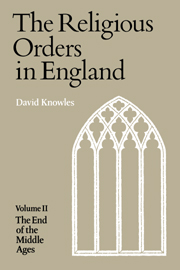Book contents
- Frontmatter
- Contents
- Preface
- List of Abbreviations
- Part One The Historical Framework
- Chap. I The opening of the period
- Chap. II Monks and canons at the university, 130c–1450
- Chap. III Patrons and architects: Ely and Gloucester
- Chap. IV Portraits of monks
- Chap. V Monks and friars in controversy
- Chap. VI Trends in speculation: Ockhamism, justification and grace
- Chap. VII Criticism of the religious in the fourteenth century
- Chap. VIII The spiritual life of the fourteenth century
- Chap. IX Developments within the orders: I
- Chap. X Developments within the orders: II
- Chap. XI The fortunes of the Cluniac houses and the alien priories
- Chap. XII The loosening of discipline
- Chap. XIII King Henry V
- Chap. XIV More portraits of monks
- Chap. XV The second century of visitation, 1350–1450
- Chap. XVI The spiritual life of the fifteenth century
- Part Two The Institutional Background
- Appendix I Chaucer's monk
- Appendix II Henry V and the Westminster recluse
- Appendix III Regulars as bishops
- Bibliography
- Index
Chap. XV - The second century of visitation, 1350–1450
Published online by Cambridge University Press: 28 January 2010
- Frontmatter
- Contents
- Preface
- List of Abbreviations
- Part One The Historical Framework
- Chap. I The opening of the period
- Chap. II Monks and canons at the university, 130c–1450
- Chap. III Patrons and architects: Ely and Gloucester
- Chap. IV Portraits of monks
- Chap. V Monks and friars in controversy
- Chap. VI Trends in speculation: Ockhamism, justification and grace
- Chap. VII Criticism of the religious in the fourteenth century
- Chap. VIII The spiritual life of the fourteenth century
- Chap. IX Developments within the orders: I
- Chap. X Developments within the orders: II
- Chap. XI The fortunes of the Cluniac houses and the alien priories
- Chap. XII The loosening of discipline
- Chap. XIII King Henry V
- Chap. XIV More portraits of monks
- Chap. XV The second century of visitation, 1350–1450
- Chap. XVI The spiritual life of the fifteenth century
- Part Two The Institutional Background
- Appendix I Chaucer's monk
- Appendix II Henry V and the Westminster recluse
- Appendix III Regulars as bishops
- Bibliography
- Index
Summary
The bishops' registers, with scarcely an exception, yield little or no information for the second half of the fourteenth century. For the most part they are less comprehensive than before, and contain little more than records of ordinations and institutions. By way of compensation, however, the activities of the monastic visitors, hitherto almost without record, can be studied in greater detail between 1360 and 1390 than at any other time before or after. Yet it is not the regular visitors from chapter that have left most traces, but a series of extraordinary visitations by Abbot Thomas de la Mare of St Albans.
That eminent man, by far the most distinguished abbot of the century, had been one of the abbots president almost without a break from shortly after his accession, c. 1351, and soon acquired a unique reputation as patron and reformer. It was his personal prestige, and not strictly his official position, that led Edward III, c. 1362–5, to call him in to deal with the affairs of half a dozen monasteries in which the king took interest as hereditary founder or patron, and which, owing it may be to abnormal years after the great plague, stood in urgent need of reform. The first of these was Eynsham where, we are told, de la Mare effected a wonderful change for the better. Part of the process of this visitation appears to have survived in a long examination of the abbot which reveals much of the domestic and economic structure of the place.
- Type
- Chapter
- Information
- Religious Orders Vol 2 , pp. 204 - 218Publisher: Cambridge University PressPrint publication year: 1979



